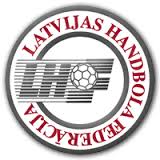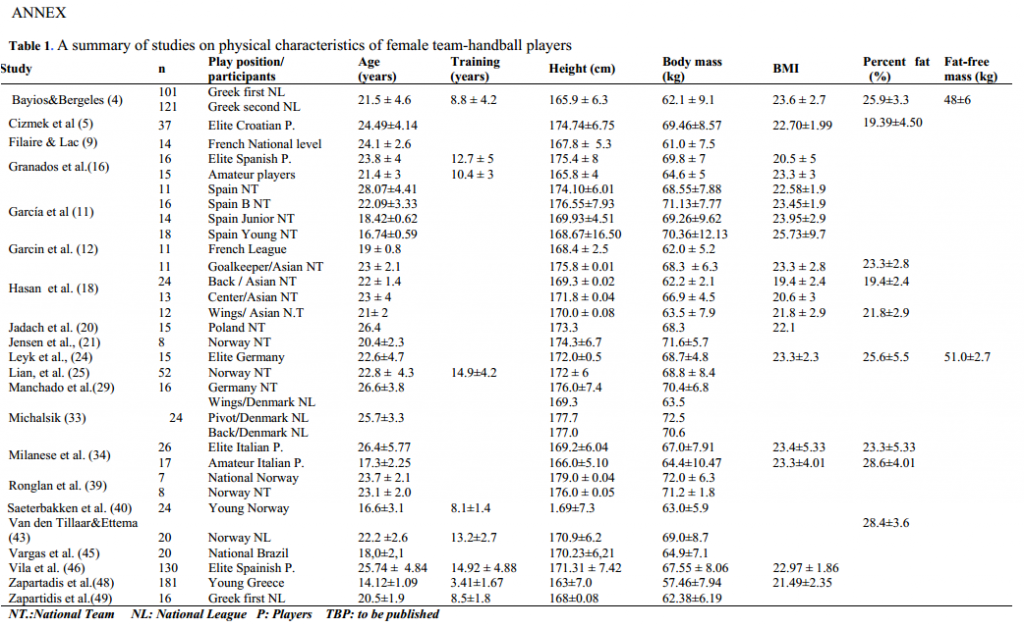
Carmen MANCHADO1 ; Juan TORTOSA1 Helena M. VILA.2 ; Carmen FERRAGUT3 1 Faculty of Education. University of Alicante. Alicante. Spain 2 Faculty of Education and Sport Science. University of Vigo. Pontevedra. Spain 3 Faculty of Medicine. University of Alcalá. Alcalá de Henares. Spain
Summary The purpose of this article was to review a series of studies (n=33) on physical characteristics, physiological attributes, physical attributes, throwing velocity and on-court performances of women’s team handball players.
Keywords Anthropometric characteristics, sports performance, throwing velocity, on-court performance
Introduction Since its introduction in 1972 at the Summer Olympic Games (18), handball has become more popular as a sport in general. Handball is a very strenuous body-contact sport characterized by highly developed motor skills such as speed, explosive power, endurance, and strength (40). The athlete’s performance in high-level women’s handball depends directly on diverse physiological attributes. In order to reach maximum player performance in handball, it is essential to use knowledge from various sports-related domains, including exercise physiology and sports medicine (50). The importance of women’s handball in research literature has grown exponentially, with the most relevant articles published over the last five years (2, 13, 16, 17, 18, 20, 24, 26, 29, 40, 45, 46, 47, 48). We also have included some of our own unpublished data with a special focus on on-court movement characteristics. Nevertheless, evidence-based knowledge for trainers and sport scientists regarding women’s elite team handball is limited, although necessary for further developing player’s skills and handball in general. Therefore, the first objective of this review is to summarize the scientific knowledge in women’s handball. Thus, the current article has two aims: (a) to review a series of studies (n=33) on physical characteristics, physiological attributes, throwing velocity and accuracy, and on-court performances of women’s handball players including: amateur players, professional players, and national team players and (b) to summarize the status of scientific knowledge in women handball including fields with a clear need for further studies in order to stimulate more.
Methods A review of the literature on physical and physiological aspects of women handball players was conducted. The reviewed articles were selected from an extensive search of the literature in English, including major computerized databases (PubMed, Medline and SPORT Discus) and library archive search tools. Various combinations of keywords were used, including: handball, team, women’s, women, physiological, physical and player. Data from unpublished studies conducted by the authors were also included. Ultimately, thirty three articles were included in this review.
Results and discussion In order to plan, design and implement successful short-term and long-term training programs for women handball players, it is essential to gather information about the physical characteristics and physiological attributes of the players.
Physical characteristics It is well known that body size affects physical performance. A taller person would perform better in activities with a significant strength component. Athletes specialized in throwing events are taller, heavier and more muscularly built than non-throwers. Body size has a strong positive effect on throwing performance and isometric strength (43, 47). A summary of the physical characteristics of women’s handball players across the reviewed studies is presented in Table 1 (see Annex).
In order to succeed in specific sport activities, it is often necessary to have certain physical characteristics. For ball games in which it is essential to use one’s hands, hand morphology and functional properties may play a key role for performance (2). It is believed that a stable ball grip allows the athlete to accelerate the ball to a maximum during the entire throwing movement (42).
In conclusion, players with a higher skill level are taller and have a higher fat-free mass (4, 16, 34, 35, 43, 47). Players with larger hand can grab the ball more tightly and this fact probably gives the player the confidence to accelerate the ball as much as possible throughout the whole movement pathway (2, 42, 47).
Physiological attributes Handball is a team sport of an intermittent nature which requires considerable physiological attributes such as the aerobic profile. A high aerobic capacity appears to be important in order to maintain a high level of performance over the 60 min of playing time.
Aerobic profile
Eleven studies examined the aerobic capacity of women’s handball players. Seven of the studies mentioned collected maximal oxygen consumption (VO2max) data of players from different competition levels, while the others focused on run velocities corresponding to certain blood lactate concentrations (Table 2 – see Annex).
Physical attributes
Modern style handball involves intense physical contact throughout the entire match in defense, counterattack and positional attack. Only players with high physical capacities can effectively satisfy such requirements (20). Thus, physical attributes such as power and strength, running speed, and throwing velocity are important factors for success in competitive women’s handball. Therefore, these capacities are now discussed for women handball players.
Power and strength
Muscle strength is an important factor in handball performance (23). Most researchers agree that higher maximal power and strength may be associated with an advantage in blocking, hitting, pushing (16) and ball throwing velocity (3, 10, 22, 31).
Differences in power and strength have been shown to be relatively marked between elite and amateur players. These findings suggest that high absolute values of maximal strength and muscle power are required for successful performance in elite women’s handball. Running speed
Running speed is an important prerequisite factor in competitive handball (10). The power of the lower extremities and the maximum running speed are significantly correlated with ball throwing velocity (16, 31, 49). This is supported by the fact that the main factor affecting ball velocity is the effective energy transition from the ground to the lower extremities and through the kinematic chain to the throwing upper limb (3, 22). Throwing velocity and accuracy
Throwing ability is one of the most vital skills in handball and a very important aspect for success (16). For a throw to be effective, the highest velocity at ball release in combination with aiming accuracy is required (19). The faster the ball is thrown at the goal, the less time the defenders and the goalkeeper have to save the shot.
A summary of studies examining throwing velocity and accuracy in women’s handball players is presented in Table 3 (see Annex). These data should be interpreted with care, because there are very few studies, the methodologies used are different (radar gun, photogrammetry, photocell gates) and sample levels vary as well.
On-court performances
Time-motion analysis is an effective method of quantifying the demands of team handball and provides a conceptual framework for the specific physical preparation of players. An effective and efficient training regime should be based on a time-motion analysis and should include intermittent drills in which handball players have to perform different motions with different paths/movements at the highest intensity possible, followed by lower intensity periods, all according to the specific demands of each playing position.
carmen_manchado@hotmail.com


